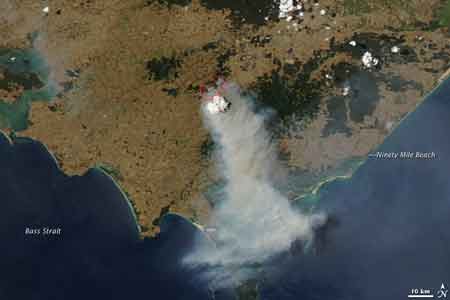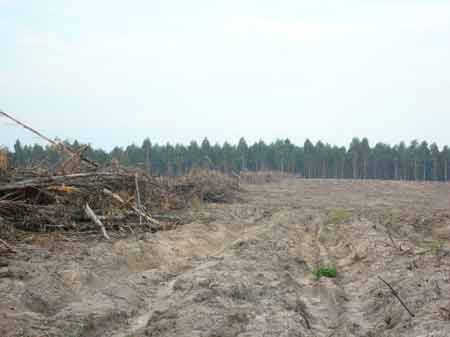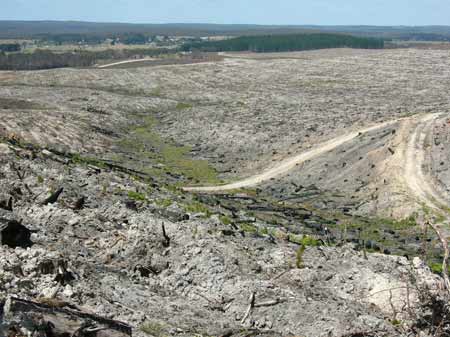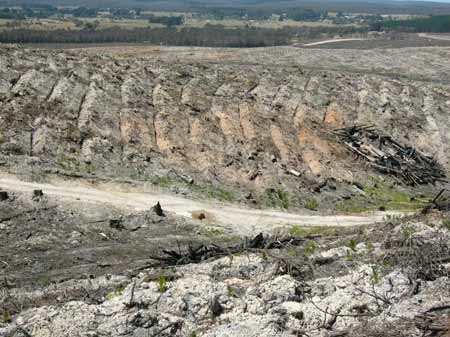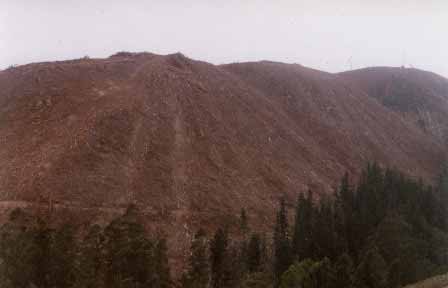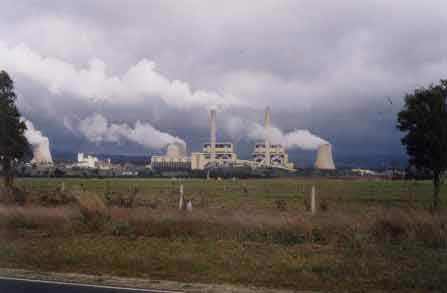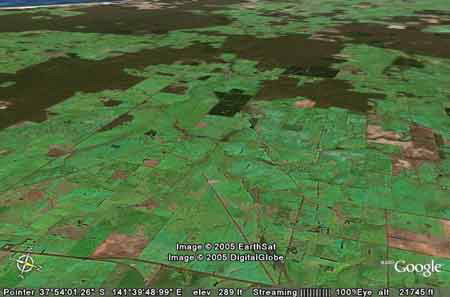Carbon Credits |
| Venture | Amortized Cost | Unrealized Loss |
| Venezuelan oil company with US dollar based flows | $154.5 million | $(25.8) million |
| Argentinian trust holding rights to oil & gas | $43.6 million | $ (20.9) million |
| Joint venture with a Venezuelan oil company | $41.3 million | $(16.4) million |
| Joint venture with a Venezuelan oil company | $63.0 million | $(14.4) million |
| Lease financing with US fossil fuel power generation | $84.2 million | $(11.9) million |
| Joint venture with a Venezuelan oil company | $62.2 million | $(11.5) million |
| Large US based merchant energy generator | $70.9 million | $(11.5) million |
| Finance subsidiary in US paper/wood products | $207.0 million | $(10.4) million |
| US power generator with multiple plants | $98.9 million | $(10.0) million |
"As of Sep 30, 2003 we had 91 securities, representing 17 credit exposures that had an unrealized loss of $10 million or more" (edited version above) Quarterly Report pursuant to section 13 or 15(d) of the Securities Exchange Act of 1934. John Hancock Financial Services Inc Quarterly Period September 30 - 2003.
Hancock also invests heavily in the coal industry in China through Peak Pacific via the Energy Investors Fund Group. Peak Pacific provide electricity to the Chinese grid for heat for residents and steam to industries. China is the second leading source for greenhouse gas emissions in the world, with its power sector responsible for approximately 33% of these emissions. It is invisaged that the vast majority of China's power plants will remain coal powered into the forseeable future.
Hancock through its joint venture with the Canadian Insurance Company Manulife also has investments in oil and gas interests in Canada. Manulife have a multi-million dollar equity interest in MLI Resources Inc which are a holding company for oil and gas profits. Manulife also has a $5million equity in the Calgary based NAL Resources Management Ltd which is a oil and gas royalty trust. This company distributes cash monthly to unit holders from oil and natural gas operations conducted in Alberta, Saskatchewan and Ontario. Manulifes' direct investment in oil and gas reserves has been valued in excess of $300 million. (see here).
In 2002 John Hanock invested $US500 million into Arclight Capital Partners. Arclights' primary focus is in the deregulation of the North American power industry. Amongst the projects that Arclight has invested in includes the Caithness Desert Power Project in Arizona. This gas power generation plant, known as the 'Big Sandy Project' has come under heavy criticism from local indigenous and environmental groups. The project will impact on the habitat of the Southwestern Willow Flycatcher and Hualapai burial grounds. For further information on this controversial project click on Arizona Sierra Club and here. Also see article Big Sandy Doesn't Fly
Coalbed Methane
Hancock also has big investments in their 'subsidiary' Evergreen Resources. Evergreen is one of the largest developers of coal bed methane in the United States. Evergreen is based primarily in the Raton Basin in Southern Colorado and also has initiated a coalbed methane project in Alaska. This method of producing energy may be more greenhouse efficient than burning coal, but coalbed methane developments have their own host of environmental problems that cannot be ignored. An excellent website documenting serious environmental problems associated with coalbed methane production in northeast Wyoming can be found by clicking onto the Powder River Basin Resource Council website.
Other Useful Carbon Sink Links:
Hancock Natural Resources Group
In July 2001 Hancock Natural Resources Group and Hastings Fund Management launched a $200 million fund called Hancock New Forests Australia. This fund is basically a greenhouse-abatement fund which allows greenhouse-gas producing companies to invest in carbon-consuming trees to supposedly balance their carbon-dioxide emissions.
The fund apparently will spend $200 million planting 30,000 hectares of trees in nine areas in the eastern states and South Australia. Three of those areas will apparently be located in the Murray Darling Basin (www.mdbc.gov.au) and will apparently be located on previously cleared farmland. After growing for 30 to 35 years the trees will then be harvested to provide timber which will be processed in regional areas.
The plantations areas will also be managed as carbon sinks and investors will receive carbon credits as dividends each year for the first 24 years of the project. These credit dividends, which apparently will trade at between $8 and $16 per tonne of carbon dioxide equivalent, will have two uses. They can supposedly be sold by investors for cash or used by big producers of greenhouse gases to offset emissions.
10% of the new plantations will apparently be retained in perpetuity as biodiversity sanctuaries.
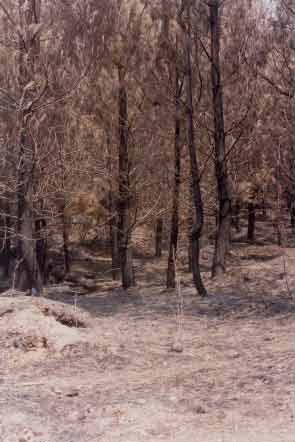
Feb 03: Gutted Hancock pine plantation near Stanley in north east Victoria. Recent bushfires in northeast Victoria destroyed over one million hectares of native forest. Hancock was extremely lucky to lose only 2000 hectares of plantation in north east victoria and several hundred hectares of plantations in Gippsland, during this natural disaster started by lightning. Under greenhouse scenarios, the risk of bushfires in South East Australia will increase significantly over the next century. Plantation companies are already struggling to pay for increased fire insurance in their plantations. In January 2003 bushfires in Canberra destroyed many millions of dollars worth of pine plantations. Are backers of Carbon Sinks properly factoring in, increased risk of fire into their plantation management strategies?
Hancock Watch remains rather sceptical of greenhouse abatement schemes due to the fact that such schemes do nothing to stop greenhouse gases being emitted from their source. Hancock Watch would rather see more attention placed on those polluting companies to reduce their greenhouse gas emissions. It should also be pointed out that the scientific community is currently assessing the whole concept of 'carbon sinks'. Some researchers claim that new plantations in some instances may even increase greenhouse emissions.
Wouldn't it be far better for revegetation schemes to be planted with indigenous species and not logged every 30 years? Surely fast rotation plantation crops will simply release carbon back into the atmosphere when logging occurs. Carbon Sinks should be looking at reafforestation with indigenous species thereby reestablishing forests rather than plantations on already cleared farmland.
Another major problem for carbon sinks is that if they are grown in the wrong locations they could actually worsen environmental problems downstream in water catchments. Recent research by the Cooperative Research Centre for Catchment Hydrology, which brings together expert land managers and scientists from universities and the CSIRO, has recently shown that upper catchments are important for delivering large amounts of water downstream, flushing out river salinity. Plantation trees in upper catchments 'drink' large amounts of water as they grow, significantly reducing natural run-off and the water yielded downstream. This can lead to less water in rivers downstream and increased salinity. Australia's number one environmental problem is salinity. What onus will there be for investors in carbon sinks to make sure that their investments are planted in the correct locations? (See The Age Newspaper January 15, 2003: Land Study Queries Tree Plantations by Melissa Fyfe - Environmental Reporter).
Hancock Watch intends to keep up to date on greenhouse abatement issues. We hope to provide more information on Hancock's greenhouse abatement plans in the near future. We also will keep a list of interesting articles on greenhouse abatement schemes from around the globe on this website.
One such site is the Carbon Sinks Watch: http://www.cdmwatch.org
Climate, Forests and The Kyoto Protocol.
Link: Issue 95 October/December 2000 Friends of the Earth International
Climate change and forests and inextricably linked. Forests contribute to environmental stability by mitigating extreme temperatures, increasing regional precipitation, and preventing soil erosion and deterioration. They are an important component in the global carbon cycle, and act as active carbon sinks in many cases. The large amount of CO2 stored in forest ecosystems is an important buffer in the process of climate change.
There is no doubt that the global loss of trees - through clearing and burning, through the conversion of forests to plantations, and through related forest fires - is having a real impact on our atmosphere. These forest activities constitute between 20 and 25 percent of total carbon emissions. Furthermore, there is increasing evidence that the world faces a positive feedback cycle in which climate change, exacerbated by forest fires, increases the frequency of the El Nino phenomenon, which in turn causes more forest burning.
How Climate Change Effects Forests
There are many scientific uncertainties about the precise impacts of climate change on forests. It has been estimated that a one degree Celcius temperature rise could alter the function and composition of forests: in some cases, forest cover will disappear completely. It may be that slow-growing species will be replaced by faster-growing, highly adaptable species. There will be more frequent outbreaks and extended ranges of pests and pathogens. Decreased precipitation and higher temperatures will result in more frequent and more intense fires.
Scientific predictions have shown that boreal forests are more strongly affected by climate change than other forest systems. This is because warming is expected to be particularly significant at high latitudes, and boreal forests are more strongly affected by temperature than are forests in other latitudinal zones.
The loss or degradation of forests can create serious environmental problems including soil erosion, flooding and drought. Forests contain as much as 90 precent of the world’s land-based species, literally millions of types of flora and fauna. Many species and varieties of plants have not yet been categorized by science, and they are sometimes restricted to very small areas. As it is, 80 percent of the original forest worldwide has been cleared, fragmented or otherwise degraded. Illegal logging, even in protected areas, continues unabated.
Not enough attention has been paid to the implications of climate change for forests. The Intergovernmental Panel on Climate Change (IPCC) estimates that at least one-third of the remaining forests may be adversely affected by climate change. More recently, the Hadley Centre for Climate Change at the UK Meteorological Office has predicted that forests will become a significant net global source of CO2 by 2050.
KYOTO FORESTS
Under the Kyoto Protocol, forests are recognized as potential sinks for carbon. This means that amounts of carbon sequestered through afforestation and reafforestation can be subtracted from a country’s assigned CO2 reductions or may be transferred under Joint Implementation.
Forest and their ecosystems hold almost 46 percent of all carbon stored. Due to climatic change and increasing population pressures, these carbon sinks are impermanent, uncertain, and represent a threat to the environmental integrity of the Protocol. For these reasons, Friends of the Earth and other NGOs have been campaigning for the exclusion of sinks from the Kyoto Protocol’s Clean Development Mechanism.
Countries would plant large-scale plantations - the so-called “Kyoto forests” - around the world in order to offset carbon dioxide emissions and obtain carbon credits. It has been estimated that between 345 million and 3.2 billion hectares could be available for this purpose if forest management activities became eligible under the Kyoto Protocol. The Washington DC-based NGO Forest Trends International projects the total annual market for carbon at US$30-100 billion.
Plantations are a way to avoid meaningful reductions in greenhouse gas emissions. Experience in many countries has indicated that plantations adversely affect natural forests and ecosystems, cause great losses in biodiversity, disrupt the social structure of local communities, and displace people from their traditional lands. They favour transnational corporations and increase social inequality. Their role in forest destruction and therefore their contribution to greenhouse emissions must be emphasized.
“Sinks” such as these probably constitute the largest loophole in the Kyoto treaty. An important factor in the expolitation of this loophole will be the extent to which well-meaning NGOs take part in these seemingly beneficial carbon forestry projects, such as those aimed at supporting existing grassroots conservation efforts. NGOs must understand that all carbon forestry projects, even those engineered to have some local benefits, will also affect other communities over a very far-flung area. All “offset” projects are designed to licence faraway companies or vehicles to continue to use a disproportionate amount of the atmosphere as a CO2 dump, and to legitimize the operations of the coalmines or oil wells needed to fuel them.
Monitoring emissions reduction projects is another potential opportunity for profit. Consultants can advise companies about where it might be profitable to look for reductions opportunities, and specialist firms are springing up to offer their services in certifying that emissions reductions are real. Some of these consultants are established NGOs; for example, the US-based Environmental Defense Fund is acting as a consultant to the Suncor company to track its emissions reductions.
FORESTS FOREVER?
The vital role of forests in maintaining the health and balance of our planet is indisputable. Forests provide clean water, habitat for rare and endangered species, sustenance for communities, and they serve as carbon sinks that mitigate global warming. Once gone, these valuable resources cannot be replaced, and scientists are now warning that we are fast approaching the point of no return.
Leonie van der Maesen FoE Australia (Based on a full-length report by Leonie van der Maesen, FoE Australia, October 2000).
Carbon Sinks in Victoria (Australia)
Parties to the United National Framework Convention on Climate Change adopted the Kyoto Protocol in 1997. Biomass contained in trees is considered to be a significant store (sink) of carbon. Under Article 3 of the Protocol, developed countries need to take into account afforestation, reforestation and deforestation and forestry activities. Article 3.4 of the Protocol states; "...additional human-induced activities related to changes in greenhouse gas emissions by sources and removals by sinks in the agricultural soils and the land-use change and forestry categories ... provided that these activities have taken place since 1990."
Clear defintions of the characteristics of Kyoto compliant forests, for the purposes of Article 3.3 is not yet available, however it could be interpreted that Kyoto forest means;
*forests (plantations?) established as a result of direct human activity;
*forests (plantations?) established after 1 January 1990; and
*forests (plantations?) established on land without significant tree cover immediately prior to establishment.
Therefore in terms of Hancock's activities in Australia, 'Kyoto forest' is;
*only forests (plantations?) established post-1990 are included
*all replanting of harvested forest is excluded; and
*all forests that replace native forests are excluded
Carbon sinks in Australia are further put into doubt because of Australia's refusal to ratify the Kyoto Agreement. Hancock has new plantation assets established after 1990. The main area where plantations have been established in Victoria after 1990 is in south western Victoria which has seen a massive increase in bluegum plantation establishment.
Recent Bluegum Developments in south west Victoria.
See also Insects Found in Victorian hardwood plantations
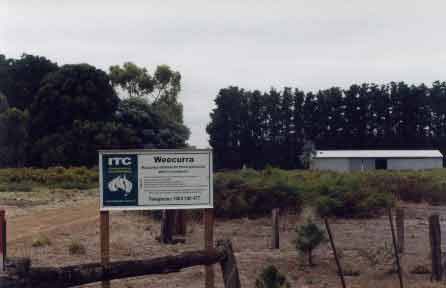
Feb 04: In August 2002, ITC in conjunction with Zurich Capital Markets completed the restructuring of the collapsed APT into Australian Forests. ITC now owns 50% of APT. Hancock Natural Resource Group is the investment manager for Australian Forests. Above is one plantation that ITC has taken over from APT. This bluegum plantation is located in the water supply for the south west Victorian town of Merino. Herbicides used by APT (and possibly ITC) in establishing the plantation included Nufarm Glyphosate CT and Mako Herbicide (Sulfometuron Methyl). Possible consquences of bluegum establishment in this water catchment include drawdown, where chemicals (including fertilisers - possibly contaminated with heavy metals) are drawn into the groundwater. ITC have recently stated that they do not use insecticides such as Dimethoate in their bluegum plantations. However, not all bluegum companies have this policy. See information on Bluegum plantation insecticides for further information. Click here
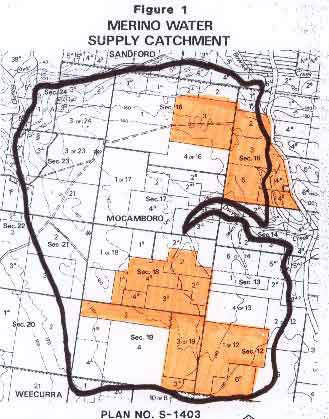
Map of Merino Water Supply Catchment outlining plantations within the catchment (highlighted in orange). The top (northern) plantation is Mocamboro pine plantation which Hancock purchased from the State Government in 1998. The bottom plantation (southern) is the bluegum plantation established by APT and now owned by ITC. More bluegums have recently been established in the eastern edge of the catchment. This could be argued as being an inappropriate establishment of plantations. Surely there is a vast amount of country that could have been established with bluegum which lies outside one of the only designated water catchments in south western Victoria. For more information about Hancock pine plantations in this catchment, click here.
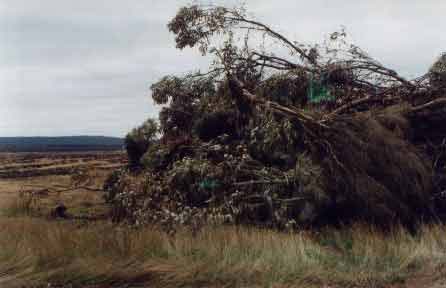
Feb 04: Bluegum establishment often comes at the removal of native vegetation. This photo reveals destruction of native vegetation in the Hotspur region, in the Crawford River catchment on Condah Hotspur Lower Road - most likely for ITC plantations.
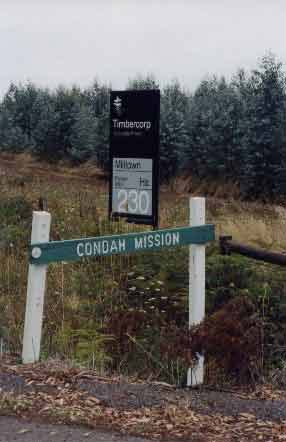
Feb 04: This plantation is located in very close proximity to Condah Aboriginal Mission. Future insecticide use in this plantation is a real worry, as is water yield reductions. We urge Timbercorp to avoid using insecticides on their plantations. Estimates of declining water yield state that plantations established on ex pasture in areas of 900 millimetre rainfall per year will use 2 million litres of water per hectare, more per year than if that land is retained as pasture. In simple terms this plantation may use 460 million litres of water per year more than what was being used for pasture and the plantation companies do not pay a cent for that water. This particular plantation drains into Darlots Creek.
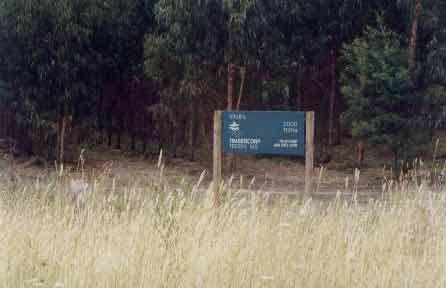
Feb 04: This plantation in the Crawford River catchment is only 3-4 years old and will be logged at about 15 years of age. Almost all of the plantations being established in the South West are grown for woodchips not saw logs. The plantation company Timbercorp (which also has a 50% stake in the collapsed assets of APT and has supply arrangements with ITC), generally has plantations scattered throughout south west Victoria concentrated mainly west of Dergolm in Victoria and north west of Penola in South Australia.

Feb 04: A very common site in south western Victoria nowadays is the influx of new bluegum plantations on ex farmland. Note the flatness of the land. None of the bluegum plantations currently in the ground are being logged at the moment. When these plantations will be logged, it will mean a huge increase in the volume of log trucks travelling in the region toward the export facility at Portland. Pressure is also coming from investors wanting to build a pulp mill in the region to be fed by the young bluegum trees.
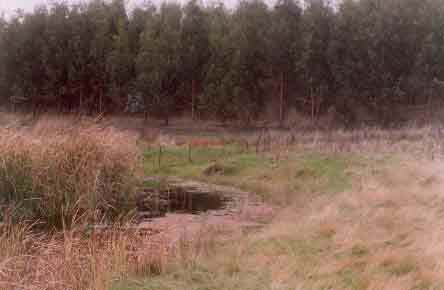
May 04: Recently established bluegums in very close proximity to the Crawford River. At this point the ITC plantations were only several metres from the river. Recent information from ITC reveals that the company has a standard policy not to use insecticides. ITC also claim that alternative management options are available besides large scale insecticide application. This is a positive outcome for this progressive bluegum company, however bluegums at the above location are too close to the Crawford River. This plantation was established by APT but is now owned by ITC.

May 04: Ex- APT Plantations located close to the Crawford River. These plantations are now managed by ITC. The Crawford River is supposed to have 30 metre buffers from either side of the river on Crown Land. Private land owners can get around this 1881 Order in Council because the Order only applies to Crown Land. (see Gazette 27th May, 1881, page 1389). Hence bluegum companies can establish plantations almost up to the river in some places.

Feb 04: Good buffers on Kangaroo Creek which drains into the Crawford River in South Western Victoria. But will these buffers stop spray drift from insecticides such as Alpha-cypermethrin & Chlorpyrifos which are highly toxic to fish? The Crawford River is home to the threatened Ewens Pygmy Perch, Yarra Pygmy Perch and Dwarf Galaxias. What impact will reduction of water yield, herbicides and insecticides have on the long term survival of these threatened species - all of which are listed under the Victorian Flora and Fauna Guarantee Act and the Federal Environment Protection Biodiversity Conservation Act? We urge all plantation companies operating in this catchment to follow the lead of ITC and refuse to use insecticides in the Crawford River catchment.

Ewen's Pygmy Perch. Facing Extinction?
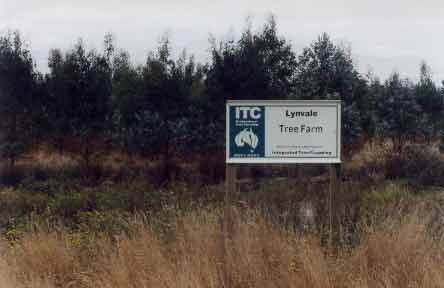
ITC plantations, many of which are mainly concentrated in the Crawford River catchment. Many of the Crawford River plantations were 'purchased' through APT. Timbercorp, GPFL and NRG also have plantations in the Crawford River catchment. ITC and other bluegum companies such as Great Southern Plantations have also been targeting ex farmland in the headwaters of the Wandoo River, Corea Creek & Robertson Creek catchments north west of the town of Coleraine - in the Glenelg River system. It appears that no bluegums have been established in the catchment of the Konong Wootong Reservoir which supplies water to the towns of Coleraine and Casterton.
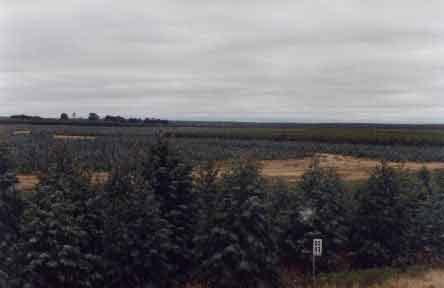
More Crawford River catchment Bluegum plantations. Hundreds of thousands of hectares of bluegum plantations have been established in south east South Australia and south west Victoria over the past 8 years. What impact will these plantations have on water yield, particularly in times of drought and low streamflow? Streamflows throughout the region could be reduced by hundreds of millions of litres each year! Also what will transpire if large bushfires hit the region?
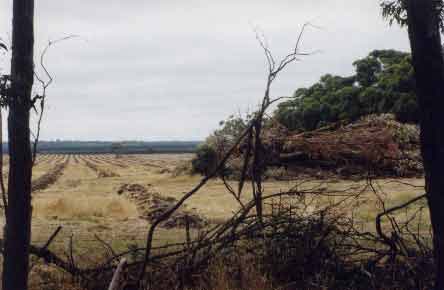
Feb 04: Recent native vegetation destruction for bluegum plantation establishment on Condah Hotspur Lower Road.
Bluegum Plantation Insecticides
BAN AERIAL SPRAYING!!!
Numerous species of insects have been recorded in Blue Gum plantations in Western Australia. These plantations were established several years earlier than blue gum plantations in south west Victoria and south east South Australia and it is anticipated that several species of insects recorded in Western Australia will also be recorded amongst more recently established bluegum plantations in Victoria and South Australia as well species of insects unique to south eastern Australia. See here for further details.
Some of the more 'common' insects found in WA bluegum plantations thus far include; African Black Beetle (Heteronychus arator), Spring beetles (Liparetrus spp.), Wingless Grasshopper (Phaulacridium vittatum), Rutherglen Bug (Nysius vinitor), Cutworm (Agrotis spp.), Calpochila spp., Heteronyx spp.), Autumn Gum Moth (Mnesampela privata), Leaf blister sawfly (Phylacteophaga froggatti), Chrysomelid beetles (Paropsis spp., Cadmus sp., Chrysoptharta spp., Trachymela sp.), Weevils (Gonipterus spp., Catasarcus spp., Oxyops spp.), Pasture day moth (Apina callisto), Leaf tier moth (Family: Decophoridae), Blue gum psyllid (Ctenarytaina eucalypti).
Standard practice for eliminating insects in bluegum plantations has been aerial spraying of insecticides over vast areas eg: In 1999/2000, 15000 ha of bluegums were sprayed with Alpha-cypermethrin & Dimethoate in Plantagenet Shire (WA) alone! This has caused controversy in Western Australia and it is anticipated that this issue will also be of widespread concern in south west Victoria. A lethal cocktail of insecticides has already been recommended for use in Western Australian bluegum plantations by the Department of Agriculture. Often these chemicals are mixed together with unknown consequences and several applications can be made in one year.
Hancock Watch remains opposed to aerial spraying of insecticides in bluegum plantations.
Insecticides recommended by WA Dept of Agriculture for Bluegum Plantations: Toxicology Data (Source: Pesticide Action Network). Click on insecticide below for further information.
Spray mixtures recommended by the WA Department of Agriculture have included;
Alpha-cypermethrin, maldison & carbaryl for control of Wingless Grasshopper.
Alpha-cypermethrin & dimethoate for control of Spring Beetles, Autumn Gum Moth, Leaf Blister Sawfly, Leaf Tier Moth & Bluegum psyllid.
Chlorpyrifos & alpha-cypermethrin for the control of African black beetle.
Chlorpyrifos & dimethoate for control of African black beetle.
Alpha-Cypermethrin is used exclusively in Western Australia to kill Rutherglen Bug, Chrysomelid beetles, Weevils & Pasture Day Moth.
The main sprays used in Western Australia are Dimethoate and Alpha-Cypermethrin. (Alpha-Cypermethrin and Chlorpyrifos are regarded as being extremely toxic to fish - meaning major problems for the Crawford River and the Glenelg River system if these insecticides are used at all in the future in south western Victoria "Alpha-cypermethrin is very toxic to fish but due to the rapid loss of alpha-cypermethrin from water its toxic effect to fish is not readily observed under field conditions . . . Alpha-cypermethrin is also highly toxic to water arthropods including crustacea").
In the excellent article 'New trials for aerial spraying of plantations being blazed out west' by Ray Fremlin - Australian Forest Grower Spring 2003; "Early plantings of blue gums in Western Australia appeared to be relatively free of insect pests. It was not until 1994 that the first widespread attack on plantations was reported. The culprit was the eucalypt weevil (Gonipterus scuttelatus) - a previously unrecorded pest in WA. Since then, the list of offending insects has increased considerably. There are now at least eight major insect pests of blue gum plantations . . . As much as 15 per cent of a tree's growth in one year can be lost through insect attack.
Growers reacted to the assault on their plantations with aerial applications of insecticidal sprays and also, recognising that the problem was industry-wide, by establishing a co-operative called the Industry Pest Management Group (IPMG) to develop strategies to manage the insect problem.
While the plantation industry was concentrating on addressing the problem through direct intervention and industry co-operation, the public was becoming alarmed about the possible detrimental effects of aerial spraying. One of the insecticides used in the aerial spraying program, dimethoate, received particular attention, with claims it was hazardous to human health and that it was being used illegally...
As a result of these mixed messages, then then Executive Director, Public Health introduced a temporary ban on the aerial application of dimethoate in May 2000, which is still in operation. Aerial spraying continued with alpha-cypermethrin, the only other insecticide available to the plantation industry.
The opposition to aerial spraying continued with various industries (particularly aquaculture, viticulture, export meat and tourism) suggesting that their viability was at stake if aerial spraying of plantations continued. These claims were voiced in spite of aerial spraying of other crops being routinely undertaken in the area. Such was the vehemence of the opposition that at a public meeting in December 2000 the then WA Minister for Agriculture, Fisheries, Monty House MLA, announced the establishment of a Community Consultative Group (CCG) to investigate aerial spraying of plantations...
RECOMMENDATIONS AFFECTING PLANTATION INDUSTRY
Of the seven recommendations developed by the group, three had direct implications on the plantation industry.
Firstly, the industry is to commission independent case studies of aerial spraying of alpha-cypermethrin onto timber plantations. Essentially, this requires the industry to monitor routine aerial spraying operations to determine if off-target movement of insecticide is likely to occur under normal operational conditions. The technicalities of implementing this recommendation are being investigated and it is anticipated that these studies will be set up over the coming year.
The second recommended the development of a generic Spray Plan, based on the Protocol for Aerial Application of Insecticides (previously developed by the Denbarker Community Group and the Plantation Industry), combined with the outcomes of discussions between the plantation industry and other industries (eg aquaculture, viticulture and tourism. Such a Spray Plan is to detail the process for communication with neighbours and is to provide opportunities for input within a designated Awareness Zone of the planned spray operation.
The development of and adherence to a Spray Plan is to be mandatory for all spray operations. Mandating the development of Spray Plan is under consideration for inclusion in the Code of Practice for the Use of Agricultural Chemicals in Western Australia. A protocol for developing a Spray Plan has been developed with input from stakeholders and this incorporates the principle or neighbour involvement in the development of a Spray Plan. All the major companies have implemented a system that provides for communication between plantation growers and neighbours in the event that spraying is necessary.
The third recommendation called for the plantation industry to implement a training program for staff involved in aerial spraying operations. While the aerial spray operators hold the licence to operate and bear most of the legal obligations, the plantation industry recognises that there is an element of shared responsibility and that its staff should be competent to supervise aerial spraying operations. The Centre for Pesticide Application and Safety, which is part of the University of Queensland, was engaged to provide a course attended by staff from all growers".
Insects found in Victorian hardwood plantations.
The most common insect defoliators found (so far) in Victorian bluegum (E. globulus) and shining gum (E. nitens) plantations include;
Wingless Grasshopper (Phaulacriduium vittatum), Autumn Gum Moth (Mnesampela privata), Leaf Blister Sawfly (Phylacteophaga froggatti), Steelblue sawfly (Perga affinis affinis), Christmas Beetles (Anoplognathus spp.), Leaf Beetles (Paropsis spp. and Chrysophtharta spp.) and blue gum psyllid (Ctenarytaina eucalypti).
Insecticides to control Wingless Grasshopper has included Malathion (Maldison).
Experiments have also been conducted in Victoria to control Steelblue Sawfly & Autumn Gum Moth using the contact insecticides: Carbaryl, Chlorpyrifos, Fenthion, Malathion (Maldison), Pyrethrins and the Systemic Insecticides: Dimethoate, Omothoate, Omeththoate. The microbial insecticide Bacillus thuringiensis has also been used in research to destroy Steelblue Sawfly and Autumn Gum Moth.
Experiments concerning the destruction of Leaf Blister Sawfly have included; Carbaryl, Malathion (Maldison), Pyrethrins and Dimethoate.
In Tasmania, Forestry Tasmania have started using Mimic (tebufenozide) insecticide to knock out Autumn Gum Moths in Shining Gum plantations & Success (spinosad) as a replacement to Cypermethrin for control of Chrysomelid beetles and lepidopteran larvae in Shining Gum plantations. Both tebufenozide & spinosad appear to be much better than what Forestry Tas were using.
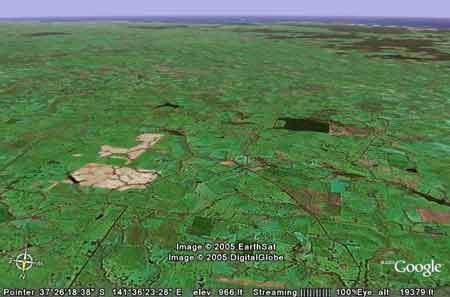
Looking south towards Coleraine (south west Victoria), circa 2001. Large scale bluegum plantations have targeted ths area since 2000.
Bluegum Insecticides Portland Observer May 2004
Friends of the Earth Melbourne Press Release 5/5/04
Plantations and Insecticides - Not a question of if but a question of when.
Friends of the Earth today warned that south west Victoria's expansion of bluegum plantations could lead to problems of insect attack, which in turn may require widespread application of toxic insecticides. These insecticides may be aerially applied several times in one year leading to potential health and economic concerns to people living nearby the plantations and businesses lieing downwind and downstream of the plantations.
Insects which could inundate bluegum plantations in Victoria include; Wingless Grasshopper, Autumn Gum Moth, Leaf Blister Sawfly, Steelblue Sawfly, Christmas Beetles, Leaf Beetles and Bluegum Psyllid.
Friends of the Earth Plantations Research Officer Anthony Amis said "Recently established plantations in Western Australia have been sprayed with insecticides which are extremely toxic to human health. The issue has caused widespread concern throughout south western Australia, with the Western Australian government placing one of the insecticides, Dimethoate under moratorium. Thousands of hectares of bluegum plantations in Western Australia have been aerially sprayed. Friends of the Earth has concerns that a similar situation will arise in south western Victoria, with bluegum plantation owners using insecticides which may cause irreversible human health and environmental problems."
Insecticides which bluegum companies may use in the future include; Chlorpyrifos, Malathion, Carbaryl, Dimethoate, Fenthion, Pyrethrins and Alpha-Cypermethrin. Mr Amis said,
"All of the listed chemicals (bar Pyrethrins and Alpha-Cypermethrin) are known Cholinesterase Inhibitors meaning that these insecticides can cause problems for the nervour system, potentially resulting in tremors, nausea and weakness at low doses and paralysis and death at higher doses. Insecticides have a similar mechansim of action in both insects and humans. Exposure to cholinesterase inhibiting pesticides has been linked to impaired neurological development in the fetus and in infants, chronic fatigue syndrome and Parkinsons Disease".
"All of the listed insecticides are suspected endocrine disruptors (bar Dimethoate, Fenthion and Pyrethrins where more information is required). Endocrine Disruptors alter levels of male and female hormones. They also interfere with proper functioning of estrogen, androgen and thyroid hormones. Exposure to such chemicals can cause sterility or decreased fertility, impaired development, birth defects of the reproductive tract and metabolic disorders" Mr Amis added.
"Furthermore Malathion, Carbaryl and Dimethoate are possible carcinogens with Pyrethrins being a known carcinogen. Dimethoate is also a known developmental or reproductive toxin. Most of the insecticides are also probable groundwater contaminants, meaning that towns and businesses relying on groundwater could be impacted by these sprays. This may be of special concern for the south western town of Merino which has large scale bluegum plantations located within its water supply catchment. Drawdown of insecticides by these plantations is a very real worry".
Also of concern to Friends of the Earth is the use of these insecticides in the Crawford River Catchment. "The Crawford River is one of the most important native fish rivers in Victoria" said Mr Amis. "The river has three species that are listed as threatened by both the State and Federal Government. These fish are; Ewens Pygmy Perch, Yarra Pygmy Perch and Dwarf Galaxias. Almost all of the insecticides listed can be highly toxic to fish. The Crawford River catchment has been inundated with bluegum plantations over the past 5 years" said Mr Amis. "If an insect attack occurs in plantations in this catchment, widespread spraying of insecticides could potentially cause major problems to these native fish. These issues should have been seriously looked at before the plantations were established".
"Two of the bluegum companies operating in the south west, Timbercorp and ITC are currently being assessed by the Forest Stewardship Council (FSC) - world's leading forest company certification scheme. Under FSC, Carbaryl and Dimethoate are prohibited under FSC rules for voluntary forest certification. However other bluegum companies such as NRG and Great Southern Plantations are not as yet going for certification under FSC meaning that they could still use Carbaryl and Dimthoate" said Mr Amis.
"We urge all bluegum plantation companies operating in south western Victoria to start to address this very serious issue" said Mr Amis. "It would be a potential tragedy if widespread aerial application of insecticides occurred in the south west. Friends of the Earth remains especially concerned about the potential impacts of this spraying on the Crawford River, Lake Condah region and Merino Water Supply Catchment. We also call on the State Government to implement bans on toxic insecticides until more information comes to hand about their known toxicity. This issue will be a 'sleeping giant' for the region" Mr Amis concluded.
Portland Observer May 12 2004. Letters to the Editor
Bluegums (1)
The organisation Friends of the Earth have a philosophical position that consumer societies are bad and because treefarms provide the raw material for paper it encourages the consumption of paper and so they should not be allowed.
While we can respect their right to that philosophy, our view, and we believe the view of most people (informed or otherwise), is that treefarms represent a sustainable means for providing the raw material necessary for what is today a basic necessity, whether the daily newspaper, tissues or writing and printing papers. In addition, and equally importantly, treefarms provide a social dividend in the form of many jobs in regional areas including southwestern Victoria and southeastern SA.
With respect to the issue of chemical spraying which Friends of the Earth is using to promote its philosophy, the issue is really about the manner in which chemicals are used in all farming, not just treefarming. This is an issue that should concern us all, whether we are users of chemicals on our farms, employers of the people applying those chemicals, or the consumers of the food grown on those farms.
As Friends of the Earth well know, Timbercorp does not use most of the chemicals thay have raised concerns about. We took the initiative weeks ago to write to Friends of the Earth telling them this. We also let Friends of the Earth know that less than 2 per cent of our treefarms across Australia are sprayed each season for pests, let alone with the chemicals they complain about. (THE LETTER NEVER ARRIVED- ED)
For Friends of the Earth to suggest that treefarmers should take the matter seriously, is beneath contempt.
Treefarmers of all people take their social and environmental responsibilities extremely seriously. I would challenge Friends of the Earth to acquaint themselves with the years of research we and our industry colleagues have conducted on more environmentally friendly products and methods of dealing with insect pests in particular to greatly reduce our overall chemical use. Timbercorp's own research has recieved both state and national awards, and was part of a detailed case study by the Food and Agriculture Organisation of the United Nations describing our holistic approach to excellence in forest management.
We are very proud of the innovation we have developed in our treefarming business, and proud to know that our operations right here in southwestern Victoria are acclaimed (by FAO) to be some of the best managed plantations in the world.
Friends of the Earth encourages governments to ban certain chemicals, which governments have done from time to time. Governments in Australia also regulate chemical use on all farms, be they tree, cereal or horticultural crops, or grazing. Timbercorp only uses products in accordance with the applicable labels and in line with government regulations. Not to mention the many and various Health and Safety regulations and Codes of Practice that we work under, all of which provide further guidance on the safe use of chemicals - all of which Friends of the Earth would be well aware.
With such a heavily regulated backdrop, the concerns of Friends of the Earth raise really become a non-issue. Had they taken the time to contact us with their concerns on this matter first, rather than get their facts wrong in a public press release, I'm sure their mind would be more at ease. We are happy to talk to anyone about our operations, and go out of our way to do this.
Finally, I would encourage readers to recognise that Timbercorp and several of our major industry colleagues are pursuing international certification by the Forest Stewardship Council. This certification promotes that our forests are managed responsibly and has the backing of the world's major environmental groups, including the Rainforest Alliance, World Wildlife Fund and Friends of the Earth. In fact, Friends of the Earth believe that FSC is the most rigorous criteria for assessing forest management regimes and also has a strong emphasis on indigenous issues and working conditions.
Why Friends of the Earth has put out such an alarmist and poorly informed press release that runs contrary to the certification process is something of a mystery.
TIM BROWNING General Manager Forestry, Timbercorp Limited.
Bluegums (2)
In response to the article on "Bluegums and Insecticides" in the Observer Friday May 7 I would like to clarify the standard management procedures of Integrated Tree Cropping (ITC).
ITC manages approximately 100,000 hectares of plantation across Australia with 30,000 hectares of bluegums in The Green Triangle Region: ITC managaes it's estate for economic returns with environmental cultural and community consideration.
It is not the standard policy of ITC to use insecticides. ITC has never applied insecticides in the Green Triangle Region, particularly in the valuable Crawford River Catchment. ITC believes that alternative management options are available besides large scale insecticide application and that large scale insecticide use is detrimental to the environment and community.
In the last 12 months ITC have only used insecticides on 500 hectares of an approximate 100,000 hectare estate on highly valuable research areas and not broad scale commercial application.
In the rare instances that insecticides are used it is by ground-based application never aerial and never within close proximity to houses, high conservation vegetation and habitat sites, waterways, dams.
ITC undertake extensive flora and fauna surveys on high value conservation sites on the properties we manage and have programs for fauna protection, flora enhancement and revegetation projects in conjunction with environmental groups. For example ITC has an extensive 10 year revegetation plan underway for over 300 hectares of riparian zone on the Crawford River and its tributaries.
ITC is aware that plantations provide valuable habitat and feeding grounds for a range of fauna, particularly birds. Recent flora and fauna field surveys on ITC managed plantations in the Crawford River Catchment have identified 19 species of birds within plantations. For example one of the species identified the Olive-backed Oriole is significant as this summer migrant likes to feed on caterpillars of the more destructive insects, such as the one that skeletonises eucalypt leaves.
In WA our bluegums are now providing a rare opportunity to help the extremely rare potoroos - one of the most endangered species in Australia. Truffles from our bluegums are being used to feed potoroos as they are insecticide free.
Further information on ITC can be obtained from our website www.treecorp.com.au or I can be contacted on 0429 920 268.
Carl Richardson ITC Regional Manager Eastern States.
Bluegums (3)
The article on the warning about insecticide use in bluegums (7/5/04) was based on a press release from Anthony Amis of the Friends of the Earth which was a complete beatup, containing factually incorrect information, and was clearly a scare tactic.
There were only two insecticides in the list given in the press release that are used in plantations in WA. One, alpha-cypermethrin is registered for aerial application in plantations. The other, carbaryl, is used in pellet baits in WA to control wingless grasshopper in agriculture, viticulture and plantations. Five other insecticides listed by Amis are not used in plantations in WA. Since companies involved in the Green Triangle, including those named by Amis, are WA-based and the chemicals are not registered for aerial use in plantations, they are unlikely to be used in Victoria.
Further, the WA Department of Health has reviewed the health and environmental effects of alpha-cypermethrin. The chemical does not affect genetic material, and when sprayed in the field, is not considered a threat to human healh in relation to chronic toxicity - a low dose exposure over an extended period of time. Studies have shown that the mixture of isomers in cypermethrin, which includes two isomers in alpha-cypermethrin, do not cause cancer, or affect a developing foetus, or affect reproduction. Alpha-cypermethrin does not build up in soil and does not tend to leach to sub-surface soil layers, and has a relatively short soil half-life, which is the time for half of the applied dose to be destroyed or dissipated.
It is very toxic to fish, but due to the rapid loss from water its toxic effect to fish is not readily observed under field conditions. Although highly toxic to marron in WA, and to bees, it has a repellent effect - marron crawl out of the water onto the banks and bees avoid contact with the chemical.
The potential economic damage to plantations from insect infestations is considerable, but in WA, in the southwest, a Community Consultative Group was set up in 2001. After making several recommendations to the Minister of Agriculture in 2002, that group went into recess until April this year.
I quote from the minutes of the most recent meeting: "There have been no incidents reported to the Health Department regarding inappropriate use of pesticides in timber plantations since the CCG#1 recommendations were adopted by the Minister", and "The Minister noted that the issues brought before the CCG relate to pesticide use in general and are not necessarily related to the plantation industry".
The (April) meeting agreed that the practices adopted by the plantation timber industry following the CCG1 were a model for all other chemical users to follow. There was far more concern about the practices of the viticulture industry in the same area eg. the use of mister-blowers to spray for insect control.
Amis has not let the facts get in the way of a hysterical beat-up.
Dr Barry Tomkins Senior Fellow, Scholl of Forestry University of Melbourne.
Unpublished Letter to the Editor 25/5/04 Portland Observer
Friends of the Earth (FoE) would like to congratulate Intergrated Tree Cropping (ITC) for their positive policy of not using insecticides in their plantations. It is definately an excellent stance that needs to be supported and their letter to the Portland Observer 12/5/04 was welcomed.
However, it is disappointing that other bluegum companies operating in South West Victoria have not followed ITC's progressive lead in eliminating insecticides from their management regimes. If it works for ITC, then why don't all other bluegum companies adopt a similar policy?
For instance Tim Browning from Timbercorp states in his letter to the Portland Observer 12/5/04 "Timbercorp does not use most of the chemicals (FoE) has raised concerns about". However Browning does not bother to inform Portland Observer readers about what chemicals his company does use or shy it has to use them. Furthermore Mr Browning alleges that "We (Timbercorp) took the initiative weeks ago to write to Friends of the Earth telling them this". No such letter has ever reached Friends of the Earth and I certainly have not been privy to reading such a letter.
In regards to the comments made by Dr Barry Tomkins - Portland Observer 12/5/04 - we are very disappointed by his inaccurate portrayal of our press release. In our press release we stated that Alpha-Cypermethrin was a potential endocrine disruptor. Tomkins gives the issue of endocrine disruption a very wide berth in his letter. Our information on all the chemicals listed in our press release was sourced from the Pesticide Action Network and can be accessed via their website. http://www.pesticideinfo.org
We also said that we have concerns about insecticides being sprayed in the Crawford River catchment which has three threatened fish species, Ewen's Pygmy Perch, Yarra Pygmy Perch and Dwarf Galaxias. Perhaps Tomkins can produce scientific reports relating to the impacts of Alpha-Cypermethrin on these species. The fact is that no tests have been conducted on these species, therefore widespread insecticide spraying on these species in the Crawford River has not been tested scientifically. Noone knows what the impact of spraying insecticides will be on these threatened species. It would be unscientifc to presume otherwise.
Tomkins also knows there was a widespread outcry from landholders in Western Australia in 2000 when bluegum plantations were sprayed with Dimethoate and Alpha-Cypermethrin. So worried of the rural backlash was the Western Australian government, thet they had to place a morotorium on the use of Dimethoate. A morotorium which is still in place today. If these insecticides are so safe as Tomkins alleges why would the Western Australian Government place a moratorium on the use of Dimethoate?
Tomkins writes that since the Community Consultative Group was set up in Western Australia, ":there have been no incidents reported to the Health Department regarding inappropriate use of pesticides in timber plantations". What Tomkins doesn't say is what happened prior to the setting up of the committee? Friends of the Earth would argue that if insecticides are to be used in south west Victoria, a similar body as the CCG needs to be urgently established to address our concerns and also to set in place an industry standard that eliminates poor practice.
The last thing the people of south west Victoria would want is a similar situation unfolding in West Auckland New Zealand, where up to 200,000 people are aerially sprayed each month for control of Painted Apple Moth. This widespread spraying is conducted largely to protect the interests of the plantation industry in New Zealand. What does Mr Tomkins say about the West Auckland issue?
Tests into controlling insects in bluegum plantations in Victoria have included the following chemicals. Malathion, Carbaryl, Chlorpyrifos, Fenthion, Malathion, Pyrethrins, Dimethoate, Omothoate and Omeththoate. This information is avaliable on the website of the Department of Primary Industry and is hardly a secret. Friends of the Earth remains concerned that there is a chance that some of these insecticides could be used in bluegum plantations if the regions comes under sustained insect attack.
Anthony Amis - Friends of the Earth Melbourne
Alpha-Cypermethrin toxic to fish
Sourced from: Review of the Scammell Report Aerial Spraying in the George River Catchment August 2004 - Tasmania Department of Primary Industries Water and Environment Tasmania Department of Infrastructure, Energy and ResourcesP2 "Molluscs generally are more tolerant of alpha-cypermethrin than many other aquatic species. Garforth 5 studied the effects of the chemical on a range of aquatic invertebrates placed in outdoor ponds. The three families of molluscs tested were all unaffected after 7 days following application of an alpha-cypermethrin spray onto the water surface at a rate equivalent to 100 g/ha; a rate some four times higher than the maximum rate applied to eucalypt plantations.
Fish, on the other hand are generally much more sensitive to the effects of alpha-cypermethrin than molluscs and in particular, oysters. Hill 3 summarised the results of various studies demonstrating 96-hr LC50 concentrations in the range of 0.4 - 3.2 ug/L for a number of fish species.
The Scammell report suggests that because alpha-cypermethrin is lipid-soluble it may have floated on the water surface to affect organisms in the inter-tidal zone of Georges Bay. However, alpha-cypermethrin sprayed onto a water surface does not remain associated with the surface layer for an extended period. Degradation in the environment and binding to soils, sediments and other particulates results in a fairly rapid loss of the chemical from the water column.
Pearson 6 for example, found that following application of a spray mix of cypermethrin to the surface of a freshwater pond, only 5% of the applied substance remained in the surface film after one day, while 19% was found in the sub-surface water."
Catastrophic macroinvertebrate drift and sublethal effects on brown trout, Salmo trutta, caused by cypermethrin spraying on a Tasmanian stream. P.E. Davies and L.S.J. Cook Inland Fisheries Commission, Hobart, Tasmania 1991
Cypermethrin, a pyrethroid insecticide, was aerially sprayed on a Eucalyptus nitens plantation in northern Tasmania, Australia. Several tributary streams of the Meander River draining the plantation received direct spray drift contamination of the order of 0.05mg/m2. Increases in invertebrate drift of over 200 times were observed on the day of spraying in Sales Rivulet. Drift was significantly elevated for 8 days after spraying, recovering both in density and relative abundance after early winter floods. Plecoptera and ephemeroptera comprised 89-92% of the drift immediately after spraying, compared with 6-21% pre-spraying and at an uncontaminated site. Benthic abundances of plecoptera and ephemeroptera decreased after spraying in all small streams draining the plantation. Early winter floods were observed to facilitate recolonistation at affected sites. Resident Salma trutta were collected from the streams before and during 6 months after spraying. Plasma chloride, glucose and protein concentrations were not affected by the spraying event. Significant transient changes in muscle RNA/DNA levels as well as brain and muscle acetylcholinesterase levels and hepatic mixed function oxygenase activity were related to the spraying event. These changes commenced around day 7 and persisted until day 26. Changes in fish diet were also observed, related to the sequence of abundant and depauperate invertebrate drift after spraying. Pathological symptoms in fish were apparently related to dietary intake of cypermethrin from dead and dying invertebrate drift.
Water Bore Fears by Terry Sim On the Land The Standard Nov 4, 2004 P1
Hawkesdale district farmers claim increasing irrigation - or blue gum plantations - could be causing stock bore levels to drop by six to 11 metres during peak demand periods.
At a meeting of the Hawkesdale branch of the Victorian Farmers Federation last week, they called for better monitoring of irrigation and stock bores and more test bores in the area.
President Roger Learmouth said the branch did not have proof of local interference between bores. But farmers were concerned about the number of irrigation licences which have been granted in the area and the impact on stock and domestic users. SRW deputy chief executive Graham Hawke told the meeting he would provide data from test bores in the Tarrone area and that the Department of Sustainability planned to do a groundwater research assessment of the district.
Tarrone farmer Bill Stanford has been lobbying Southern Rural Water and authorities over falling bore levels in the area. He recently lost a Victorian Civil Administrative Tribunal case objecting to an irrigation licence for a Spencers Road dairy farm.
Mr Stafford said district farmers were taking water from a low-yielding aquifer which he and others believed was being over-utilised, and water levels in new and old stock bores had dropped. The water level in one bore on his property sunk in 1996 has dropped by up to 11 metres from autumn to late summer.
"There is not enough water there for everybody," he said.
"To us it just seems to be too much of a coincidence.
"We have never had any problems with these bores in the previous 50 years."
Farmers had not dramatically increased stock numbers and the only major water demand changes in the area had been the number of large irrigation licences granted and the planting of blue gums, Mr Stafford said.
"We need more test bores and monitoring of irrigation bores." Mr Stafford said he would approach the Minister for Water, John Thwaites, on the issue.
The area where farmers believe irrigation bores or blue gums could be affecting supply is west and north of the declared Yangery Groundwater Supply Protection Area.
Yangery aquifer groundwater usage has varied from 45-49 per cent of the allocations over the past two years. Allocations total 8427 mega litres and the aquifer’s permissible annual volume is 11,500 mega litres.
Mr Hawke said yesterday that SRW had asked DSE at least 12 months ago to look at declaring a new groundwater management area in the area or at extending the Yangery GSPA.
He recently received a commitment from DSE that the department intended to accelerate a planned resource assessment of the area. Any resource assessment would also include the impact of blue gum plantations or other land use changes, Mr Hawke said.
He said there was anecdotal evidence of fluctuating bore levels in stock and domestic bores near blue gum plantations on hot, windy days.
Gum Blues by Glen Bernoth The Standard Nov 6, 2004 P1
Simpson, Timboon and Cobden communities fear their towns are slowly dying as the number of dairy farms sold to blue gum plantation companies nears 40.
The dairy-rich Heytesbury district will soon resemble its pre-settlement days when 44,000 hectares of bush rendered the land agriculturally useless, according to forecasts.
In a special by The Standard, farmers, politicians, town progress associations and schools fear blue gums are sounding the death knell for the district. Already school enrolments are well down, teachers have been laid-off, businesses are felling the squeeze and the local MP’s office is inundated by concerned residents.
"Blue gums are certainly affecting our enrolment. Absolutely we’ve lost families because of the blue gums," Timboon P12 School principal Bryan Ward said.
Simpson farmer Rob Leishman has calculated the economy in the southern part of the Corangamite Shire is already between $70-80 million worse off each year.
"The world is short of food and here we are planting good dairy country out in trees," he said. "When I go to heaven, I want to come back as a white ant because that’s all that will be left to eat - wood." Mr Leishman is so concerned for the future of his family he has organised a public meeting to be held at the Simpson Hall at 8pm on November 19.
Timboon resident Alan Kerr predicted 400 people will be there - such is the widespread concern in the area. Member for the Western Province John Vogels MLC and Polwarth MP Terry Mulder will also be there. They both said the issue threatened the social fabric of the area.
The issue gained prominence with a variety of the region’s stakeholders, such as the Corangamite and Glenelg Hopkins catchment management authorities. Together with the co-operation of others, they are in the final stages of a research project into the impact of blue gum plantations on ground and surface water.
Corangamite Shire has organised a workshop on November 16 with relevant groups in an effort to open up lines of communication.
Farmer sad to see dairy land go by Glen Bernoth The Standard Nov 6, 2004 p1
Peter Harkin soil his dairy herd in June this year, but said he could never watch his farming property at Paaratte turned into a blue gum plantation.
Instead, Mr Harkin diversified into beef cattle and continues to work the family farm. He said he could understand dairy farmer’s frustrations at continued poor returns, but personally made a decision never to sell to a blue gum plantation company.
"It must be very hard for a farmer to sell their farm and know it is going into trees - to just walk away and know it’s going back to bush - I couldn’t do it," he said.
"I’ve got a lot of friends who have got out of dairying and some of those have gone into trees, which is their decision. "Blue gums give farmers an option to sell - a lot of farms have been on the market for quite a while. "If you look at the upside, farmers who want to sell their property get a good, or reasonable, price for it.
"The downside is we’re losing families from the district and businesses are going to suffer - vets, stock agents, machinery dealers … "If families leave, there’s schools and hospitals as well. It’s the whole community. "It will be to the detriment of the community if more and more farmers sell to the trees - it already is to the detriment. "I went to price a car recently and the first thing the bloke said to me was that he was going to have to think about putting staff off soon if more farmers left."
Mr Harkin said the reality was, if the dairy industry was paying farmers fairer milk prices the properties timber companies were buying would never be on the market.
"I would suggest, if a tree company can afford to come in and buy good dairy land, then the land is too cheap, which is reflective of the price of milk over five or six years," he said.
Dead end on blue gum issue 300 at meeting but not all satisfied by Vanessa Burrow
The Standard, Monday, November 22, 2004 - p3
A seeming dead end has been reached in discussions about blue gum plantations in the Heytesbury region after a well-attended public meeting in Simpson.
Organisers of Friday night's meeting, which was attended by about 300 people, said the gathering achieved its aim to inform the community about the timber industry in the region.
Some dairy farmers and residents of Corangamite towns, however, have expressed their dissatisfaction with the meeting's focus.
Incumbent Corangamite Councillor Evan Savage said the meeting was positive because forestry companies had shown themselves to be willing to communicate with the Heytesbury community. "I really don't think the tree companies have done as well as the gas companies in letting people know what was going on and they needed to do better," he said. "I think (people) had their questions answered about trees, especially from timber companies, which is really what the night was about."
United Dairyfarmers of Victoria central councillor Nick Reynard was reserved in his praise for the meeting. "I thought it went well for some people but I think there's a fair bit of angst in the community," Mr Renyard said.
Cooriemungle dairy farmer Ross Powell said the meeting was a credit to the organisers but it did not present any real answers on the effect of bluegums on the local economy. The arguement that more plantations were needed to address Australia's trade deficit did not make sense to him, he said. "The dairy industry exports about $3.5 billion a year which is credited to the balance of trade and provides employment to thousands of Victorians," Mr Powell said. "If the timber companies take over dairying land there's going to be less dairy products produced and exported ... you're robbing Paul to pay Peter. "The timber industry (representatives) at the meeting never touched on what they could do for the community."
Simon Trotter, who employs five people at Timboon Plumbing, had a similar view about what was achieved on Friday night. "I was a bit disappointed with the meeting to be honest," he said. "I would have liked to see more information about the effect on the population base. "I thought that was let go through to the keeper a bit. "There will probably be a fair bit of disquiet in the community."
Meeting organiser and dairy farmer Rob Leishman said he was still concerned for the Heytesbury region and its economic viability following Friday night's meeting. "The big problem is that the dairy industry needs another 12 months of better prices before people get back on track and by that time there could be good dairy country gone," he said. "It's up to the Government to look very seriously (at) whether they want the dairy industry to keep going or not."
Weekly Times 24 Nov 2004 p1 Dairy industry fears spread of plantations
Tree Alarm by Monica Jackson
The sale of thousands of hectares of prime dairy land in Victoria's south-west to the plantation industry has alarmed dairy leaders.
As farmers continue their exodus from the industry, milk companies warn that the loss of suppliers could hurt their ability to meet future world demand.
Farmers are selling up as poor milk prices and rising costs take their toll. But what has alarmed dairy companies is the exodus from Victoria's south-west, which is considered the richest dairying country in Australia.
Dairy farmers, company leaders, timber industry representatives and local politicians packed a hall at Simpson near Colac last week to discuss the spread of plantations on prime dairy land.
The meeting was called to address farmer concerns about the impact of:
*Fewer dairy farms on local businesses, towns and rural communities, hospitals and schools.
*The effect of widespread use of pesticides and herbicides by the plantations on streams and waterways.
*Having plantations as neighbours, especially in relation to weed and pest control and increased fire risk.
*Government taxation concessions granted to plantation investors.
The meeting drew a number of concerned dairy power brokers, including Bonlac chairman Noel Campbell and managing director Bruce Donnison, Murray Goulburn chairman Ian MacAulay and Warrnambool Cheese and Butter managing director John McLean.
Mr McLean told the meeting that dairy companies did not have the right to tell farmers what to do with their land. "But in the not too distant future, world demand (for Australian dairy product) will outstrip what we can provide," he said.
The meeting was organised by Simpson dairy farmer Rob Leishman, who said he was alarmed at the rate of dairy farm sales to plantations, especially in the Heytesbury settlement, south of Colac.
Mr McLean told the meeting the region was the dairy industry's "shining light". While dairy farmers in northern Victoria struggled with water problems, and Gippsland farmers battled with pressures from urban sprawl, Victoria's south-west was ideal for further dairy growth, he said. "We forecast a production increase here of between 7 and 10 per cent and many people made substantial investments in the industry," he said.
Mr McLean said the industry acknowledged that the past two years had been tough for farmers. He said the past six months had brought a major turnaround in demand for dairy products, especially cheese, from markets such as Japan and China. "We're concerned as an industry to lose any farmers, from this region particularly," he said.
Mr McLean said the companies were doing everything possible to improve the situation. He said the heads of Murray Goulburn, Tatura Milk, Bonlac and Warrnambool Cheese and Butter had met on three occasions in the past two months to discuss how post-farmgate savings could be achieved.
Farmers said they were also concerned about the impact of plantations on farms.
Resources manager Jim Knott, of plantation company Midway, said his company used a wide variety of herbicides but each was aimed at a specific weed and all were heavily regulated.
Mr Knott said the company did not intend using insecticides or fungicides in the region. "We test stream water. We don't have to by law, but we do it anyway," he said.
Mr Knott said the company was keen to make and keep assurances to farmers that the two industries can co-exist. "We desperately want to be good neighbours and prove ourselves," he said.
Farmers who spoke to The Weekly Times after the meeting said the real social, economic and environmental impact of the plantations had not been addressed.
Even meeting organiser Rob Leishman was far from satisfied with the results of the meeting. "Thank Christ, Henry Bolte (the Premier who opened up the Heytesbury Settlement in the 1950s for dairying) is not hanging from the rafters. He wouldn't be too happy with what's happening here," Mr Leishman said.
Pastures vanishing By Monica Jackson Weekly Times 24 Nov 2004
An estimated 80,000 ha of land has been transformed into bluegum plantations in Victoria in the past three years and the timber industry is hungry for more land.
According to the Department of Sustainability and Environment, Victoria will have a plantation estate of more than 750,000 ha within 15 years if the current rate of planting continues.
There are 28 forestry investment companies operating in the state with the blessing - and some would say generous taxation concessions - of the Federal and State governments.
Both levels of government have endorsed the Plantations for Australia: the 2020 Vision plan which has a target of trebling the country's plantations to three million hectares. The scheme aims to overcome the annual $2 billion trade deficit caused by Australia sourcing forest products from overseas.
Editorial 24 Nov 2004 The Weekly Times Plantations can't go unchecked
Timber plantations continue their inexorable march across the Victorian landscape.
But rather than take up marginal land, timber companies have been moving into the richest land in Australia - the dairying region of Victoria's south-west.
It is a sign of the desperate times faced by the dairy men and women of this state that they can be persuaded to sell up and leave their community.
Dairy company leaders are saying the large number of dairy farms being sold to plantations could jeopardise the industry's ability to fill export contracts. But they cannot guarantee better prices in the future. And the farmers who are leaving cannot be blamed.
Falling milk prices, two of the dairy industry's toughest seasons and a rising dollar have caused ongoing pain throughout the industry. For many farmers, the good money being paid by plantation companies is their only chance to recoup some money after a lifetime of struggle and hard work.
It begs the question: if dairy farmers cannot prosper in the richest dairy region in Australia, where can they?
And what about the farmers who remain? They deserve answers to pressing questions about the impact of the change in land use.
How will the transition from dairy to timber plantations affect their local communities, businesses, schools and hospitals? And is co-existence with the plantations possible?
In an attempt to rectify Australia's trade deficit, governments of all persuasions have encouraged the expansion of timber plantations.
But what controls do they have over the plantations' use of pesticides and herbicides?
There is plenty of anecdotal evidence, especially from Tasmania, about water contamination, concerns about aerial spraying and lack of accountability from plantation owners.
Victorian farmers need to be assured the same does not occur here.But the evidence appears to be contrary.
At a packed meeting organised by concerned farmers in Simpson last week, a plantation official admitted that there was no law forcing the compant to test for herbicide residue. He said the company did so anyway.
Comments like this reinforce farmers' view that plantations are a law unto themselves.
Farmers left the meeting frustrated at the lack of information provided.
The timber industry is adding another stress to an already struggling community in south-west Victoria. The farmers deserve answers.
Bluegum impact hits home by Glen Bernoth Warrnambool Standard January 4, 2005.
Acting Premier John Thwaites has conceded there is little the Government can do to arrest communities' fears that blue gum plantations will cripple their towns' economies.
Timboon, Simpson and Cobden have all reported slowed economies. Progress groups, schools and traders blame the proliferation of plantations in the area.
It is believed more than 40 cash-strapped dairy farmers have sold their farms to blue gum plantation companies. Many of those farming families have left the district.
Yesterday Mr Thwaites, the Victorian Environment Minister, said the Government was aware of the situation but could not step in and fix it. "You can't step in and stop people from selling properties on the basis that you want to maintain numbers in a school, for example," he said. "The Government just doesn't have the role or power to do that. "We're certainly prepared to talk to communities, talk to local government, to see if there are ways to ensure that communities and schools have a future. "We're a Government that is opening new schools rather than closing them but you can't step in and prevent farmers from selling their land.
Government can't stop particular farm uses in order to get a social objective." Mr Thwaites said the Government also had no means to pressure milk prices up so that families would be more inclined to stay on farms and in communities.
"Once again, that is private enterprise and the private enterprise system is not something that Government can direct," he said. "Hopefully milk prices will rise. "There have been fluctuations over time and we would hope milk prices will rise and farms will remain viable.
"Farmers have to make the best economic use of their land and its difficult for Government to step in and tell farmers that they can't use land for blue gums or other plantations."
He said the blue gum industry had its benefits too. "Plantations do provide wood that we all use. "Using plantations means there is less pressure on native forests and we protect native forests.
"Unless people stop using paper and wooden products we are going to keep needing wood.
"The main issue with plantations is water and we have to ensure they don't unduly affect the water table or take excessive amounts of water."
| Web work by www.green.net.au |
